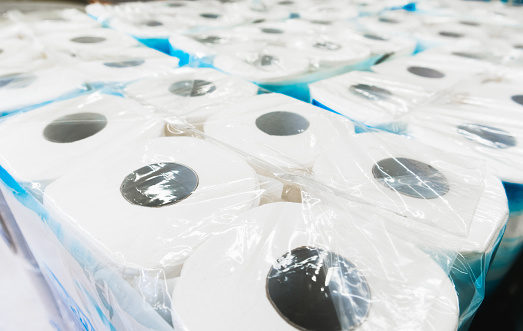 In the wake of the coronavirus hysteria, images of empty store shelves have triggered a few things: even more panic buying, a social media frenzy of hoarder shaming and even gang activity linked to toilet paper theft in Hong Kong. Many stores are implementing limits on how much toilet paper, hand sanitizer and other products people can purchase, with some stores even dispatching security guards to watch over the aisles and ensure customers aren’t taking more than their fair share.
In the wake of the coronavirus hysteria, images of empty store shelves have triggered a few things: even more panic buying, a social media frenzy of hoarder shaming and even gang activity linked to toilet paper theft in Hong Kong. Many stores are implementing limits on how much toilet paper, hand sanitizer and other products people can purchase, with some stores even dispatching security guards to watch over the aisles and ensure customers aren’t taking more than their fair share.
For many supply chain leaders, this presents the enormous and potentially costly challenge of dealing with the bullwhip effect. When major swings in inventory occur from panic buying and hoarding, the impact of this sudden demand is magnified as it moves upstream in the supply chain (similar to the way a bullwhip’s thong amplifies in a wave as it moves away from the handle). The customer feels the pain of empty aisles. The retailer loses potential sales and customer service suffers. Distributors are left scrambling to determine who should get how much of a given product in a shortage, and manufacturers are overwhelmed with sudden, unanticipated spikes in demand.
The primary causes of this bullwhip effect are little or no visibility into demand patterns and limited understanding of demand drivers. When the market (or the media) signals a sharp increase in demand, especially in times of global crisis, supply chain leaders’ profitability depends on being informed and agile enough to forecast and fulfill inventory at the right speed, in the right places, at the right time.
Trigger point: The domino effect of panic buying
What panic buyers likely don’t realize is that their stocking up signals “false demand,” contributing to a whole slew of bullwhip effect problems further up the supply chain. For example, as fear mounts around COVID-19, global delivery times are the longest they’ve been in almost ten years while manufacturers, distributors and retailers are struggling to keep up with stock-outs and rising demand.
Without real-time demand data and end-to-end visibility across the entire supply chain, retailers simply can’t maintain steady inventory — at least at the speed required to replenish a season’s worth of goods overnight. "Our employees and suppliers are working tirelessly to try and keep up,” said Patrick Noon, managing director of Costco Australia, where the country's stores sold 192,000 rolls of toilet paper in 30 minutes.
When you buy 100 rolls of toilet paper (and you normally buy 10 at a time), you’re essentially sentencing factory workers, truck drivers and retail store associates to hours and hours of overtime in the middle of a healthcare crisis. Not to mention, the long-term effect of panic buying means supply likely won’t be replenished by the next time you need toilet paper because those with reserves at home have inadvertently created a shortage in their panic to stock up.
The Goldilocks approach: Finding just the right fit for true demand
It’s estimated that most people use one roll of toilet paper per person, per week. That would mean a family of four quarantined in their home would need 16 rolls per month on average. In the midst of worldwide coronavirus quarantines, there is no evidence to indicate that people have a need to, or are actually, using more toilet paper than they normally would. While there may be some increase in consumption due to all family members being home when they would otherwise use resources at a place of work all day, there’s no data to support that overall consumption will rise. It appears that people are hoarding and stocking items in their home pantries, which in turn means that they won’t be buying TP in the next few months. Therefore, suppliers, manufacturers and retailers can expect low demand and plan accordingly.
Meanwhile, hand sanitizers, disinfectants and tissues are also being purchased at much higher rates, but consumption of these products is also increasing. While these items are flying off the shelves and some pantry loading is taking place, hand-washing and sanitization recommendations from the media and government agencies are driving up true demand. Therefore, supply chain leaders can expect a steady or slightly lower demand as the coronavirus curve flattens.
At the other end of the toilet paper spectrum, hospital consumables like masks, gowns and gloves (some of which are also being purchased by everyday consumers) have highly increased consumption with no end in sight. Therefore, we can expect demand to remain high for the next several months.
Mitigating supply chain risk today and tomorrow
In our current situation, the media is providing daily insight into demand spikes around the world, giving supply chain leaders a good understanding of demand and the underlying drivers (government mandates and recommendations, fear, panic, etc.) Together with this knowledge and concurrent planning, supply chain leaders will have the insight to survive and thrive through the coronavirus and other disruptions, with the power to understand real-time supply and demand and proactively plan accordingly. Whether the next disruption is caused by natural disaster, financial crisis, political upheaval or some other unforeseen event, planning for the worst, adequate and best-case scenarios ensures supply chains will be able to weather the storm.
Together, we will prevail over the COVID-19 disruption, and with the correct mindset and technology in place from our learnings through this crisis, preparing for the new normal of inevitable volatility will allow businesses to quickly respond to changing market dynamics, reduce disruption to customers, maintain sustainability and minimize impact to profitability through future supply chain disruptions.
Read our 5 disruption response best practices brochure to learn more about risk mitigation for today and the future.






